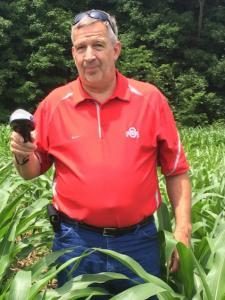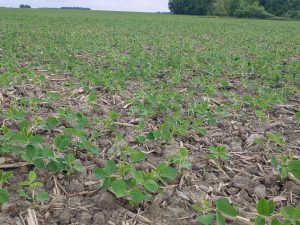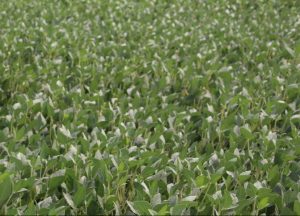On Farm Soybean Population Study
By Bart Johnson and Dusty Sonnenberg, CCA, Ohio Field Leader: a project of the Ohio Soybean Council and soybean checkoff.
There is a difference between raising the highest yields and earning the greatest profitability. When farmers look at factors that have the biggest impact soybean yield, research conducted by Dr. Laura Lindsey, Ohio State University Extension State Soybean Specialist, has shown that planting date has the single biggest impact. As farmers evaluate overall profitability, lowering seed cost by lowering planting population is an area that growers can manipulate in an attempt to increase profitability.

Darke County farmer, Aaron Overholser, has been working on a soybean planting population trial with the help of Sam Custer, OSU Extension Educator, for several years. Overholser has been finding lower populations are yielding similar to the higher populations. The 2020 population trial consisted of 4 targeted seeding rates. Rates were: 160,000, 120,000, 80,000 and 60,000 seeds per acre. Overholser’s initial goal was to push the boundary of lowest population down to a target rate of 40,000 seeds per acre. Unfortunately, physical limitations of the planter only allowed a bottom seeding rate of 60,000 plants. Actual plant stand counts conducted at the V3 growth stage were 155,000, 116,000, 75,000, and 63,000 plants per acre respectively.
In evaluating the crop, Overholser noted that post planting conditions were not ideal. “We received a couple heavy rain events shortly after planting, and nighttime temperatures dropped to around 28 degrees prior to emergence,” said Overholser. In spite of the weather, “the emergence was very good, and the soybeans came through well. Early in the growing season, it was easy to pick-out the lower plant populations in the field, but as the season went on and the beans canopied, it was hard to tell them apart. In years past a difference in height was noticeable, but that was not the case this year.”
After harvest, an analysis of the yields from each population treatment were evaluated statistically. The population treatments were randomized and replicated across the field. There was no statistical difference between the yields of the different population treatments. Averaged treatment yields ranged from 65.4 bushels per acre to 67.5 bushels per acre. When evaluating the treatments from an economic rate of return, the higher population treatments actually had lower economic returns than the lowest population treatment. This means that in this particular study, the higher populations only increased the seed cost to the farmer, but did not show a statistically significant increase in final yield or economic return.
Neither Overholser or Custer are ready to recommend a target rate of 60,000 seeds per acre for everyone, however the research does provide valuable information in the yield potential if a farmer is considering replant decisions due to poor emergence. “I think if a farmer has a uniform stand, even if the population is lower than what was originally intended, this study has shown that populations in the 60,000 range (if uniform) can yield as well as the higher populations,” said Custer. “While we are not ready to recommend populations of 60,000 seeds per acre for every acre in Ohio, a sweet spot may be to target around 130,000.” Overholser plans to target a population of 140,000 to 150,000 for most of his acres in 2021.
Aside from reducing seed cost while trying to maintain final yield, one area of concern to note with lower plant populations is the potential for weed control issues. That was not a problem in 2020 for Overholser, however it is a factor to be aware of, especially if the stand is not uniform across the field.
More details and final results from this study will be available when the 2020 OSU eFields report is published in early January 2021.
is published in early January 2021.
Darke County, Ohio is not the only place where soybean population studies are being conducted. In 2019, a multi-state soybean seeding rate study was conducted across 211 fields. Ohio had both small plot and on-farm research included in this study. The research was grouped by growing environment conditions, and further grouped by yield potential. Low yield areas were defined as having a yield potential below 58 bu/ac. The medium yield potential range was 58-71 bu/ac. High yielding potential was considered greater than 71 bu/ac. The agronomic optimum seeding rate for low yield potential was 170,000 seeds per acre. The agronomic optimum seeding rate for the medium yield environments was 146,000 seeds per acre. The high yield environment agronomic optimum seeding rate was 128,000 seeds per ac. Economic seeding rates would most likely be the same or lower for each of these environments.